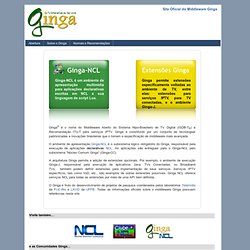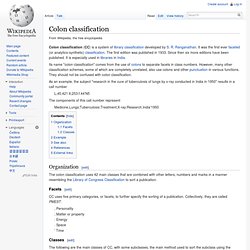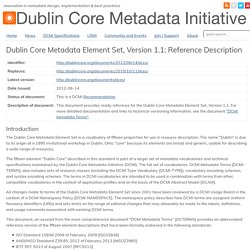

Inicio. Ginga® é o nome do Middleware Aberto do Sistema Nipo-Brasileiro de TV Digital (ISDB-TB) e Recomendação ITU-T para serviços IPTV.

Ginga é constituído por um conjunto de tecnologias padronizadas e inovações brasileiras que o tornam a especificação de middleware mais avançada. O ambiente de apresentação Ginga-NCL é o subsistema lógico obrigatório do Ginga, responsável pela execução de aplicações declarativas NCL. As aplicações são entregues para o Ginga-NCL pelo subsistema “Núcleo Comum Ginga” (Ginga-CC). A arquitetura Ginga permite a adição de extensões opcionais. Geotagging. Geotag information in a JPEG photo, shown by the software gThumb The related term geocoding refers to the process of taking non-coordinate based geographical identifiers, such as a street address, and finding associated geographic coordinates (or vice versa for reverse geocoding).

Such techniques can be used together with geotagging to provide alternative search techniques. Geotagging techniques[edit] The geographical location data used in geotagging will, in almost every case, be derived from the global positioning system, and based on a latitude/longitude-coordinate system that presents each location on the earth from 180° west through 180° east along the Equator and 90° north through 90° south along the prime meridian.
[citation needed] Geotagging photos[edit] There are two main options for geotagging photos; capturing GPS information at the time the photo is taken or “attaching” the photograph to a map after the picture is taken. GPS formats[edit] Recognize Faces & Objects in Videos & Photos using our Custom Computer Vision Technology. We develop custom software that identifies objects in photos and videos.

Finding objects in digital images, photos and videos Searching by image - using images as search criteria Counting and measuring applications (parts, cars, people, metal sheets, pills, grain, birds, ...) Tracking moving objects in video Facial recognition, head tracking, face tracking and analysis, Human Action Recognition Video Content Analysis Recognize Faces & Objects in Videos & Photos Identify and track faces and objects in video Our technology identifies faces and objects in video. As an implementation of Recognition Technology, our software learns to recognize a face or object using an initial training set of sample images. To improve its accuracy, our solution also uses Tracking Technology and User Assistance where the user has the option to correct mistakes. The software tracks each item it finds in the video.
When the initial, automated detection completes, the user has the option to confirm the findings. Victorinus _Cícero e circuntâncias. Parametros eng. Colon classification. Colon classification (CC) is a system of library classification developed by S.

R. Ranganathan. It was the first ever faceted (or analytico-synthetic) classification. The first edition was published in 1933. Since then six more editions have been published. As an example, the subject "research in the cure of tuberculosis of lungs by x-ray conducted in India in 1950" results in a call number L,45;421:6;253:f.44'N5 The components of this call number represent Medicine,Lungs;Tuberculosis:Treatment;X-ray:Research.India'1950 Organization[edit] The colon classification uses 42 main classes that are combined with other letters, numbers and marks in a manner resembling the Library of Congress Classification to sort a publication. Facets[edit] CC uses five primary categories, or facets, to further specify the sorting of a publication. . , Personality ; Matter or property : Energy . ' Time Classes[edit] z Generalia 1 Universe of Knowledge 2 Library Science 3 Book science 4 Journalism B Mathematics B2 Algebra J2 Feed.
Starship Troopers - Citizen Rule. Starship Troopers (1997. Indexação (biblioteconomia) Origem: Wikipédia, a enciclopédia livre.

A indexação, ou representação temática, é a ação de descrever e identificar um documento de acordo com o seu assunto. Para haver qualidade na produção dessa leitura, é viável que as operações documentárias sejam feitas de maneira objetiva, visando o acesso a todas as fontes de informação de uma biblioteca ou centro de documentação. Com o objetivo de encontrar facilidade em fazer uma indexação, é necessário que o bibliotecário estabeleça alguns parâmetros para a facilitação do seu trabalho.
Dublin Core Metadata Element Set, Version 1.1. Introduction The Dublin Core Metadata Element Set is a vocabulary of fifteen properties for use in resource description.

The name "Dublin" is due to its origin at a 1995 invitational workshop in Dublin, Ohio; "core" because its elements are broad and generic, usable for describing a wide range of resources. The fifteen element "Dublin Core" described in this standard is part of a larger set of metadata vocabularies and technical specifications maintained by the Dublin Core Metadata Initiative (DCMI). The full set of vocabularies, DCMI Metadata Terms [DCMI-TERMS], also includes sets of resource classes (including the DCMI Type Vocabulary [DCMI-TYPE]), vocabulary encoding schemes, and syntax encoding schemes.
The terms in DCMI vocabularies are intended to be used in combination with terms from other, compatible vocabularies in the context of application profiles and on the basis of the DCMI Abstract Model [DCAM]. References The Elements.